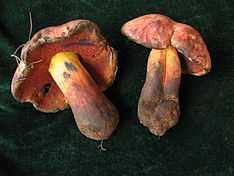Suillellus queletii
| Suillellus queletii | |
|---|---|
 | |
| Scientific classification | |
| Kingdom: | Fungi |
| Division: | Basidiomycota |
| Class: | Agaricomycetes |
| Order: | Boletales |
| Family: | Boletaceae |
| Genus: | Suillellus |
| Species: | S. queletii |
| Binomial name | |
| Suillellus queletii (Schulzer) Vizzini, Simonini & Gelardi (2014) | |
| Synonyms[1] | |
| |
Suillellus queletii (formerly Boletus queletii), commonly known as the deceiving bolete, is an uncommon, edible mushroom in the genus Suillellus. It can be found in deciduous forest, at lower altitudes, mostly under beech. Originally described in 1885 as a species of Boletus,[2] the fungus was transferred to Suillellus in 2014.[3]
Description
The cap is hemispherical, latter flattening out, appearing olive to reddish-brown, rarely also dark red. The flesh is yellow, turning blue when cut. The pores are yellow with olive spores. The stipe is smooth and golden yellow. The flesh has a slightly acrid taste.[4]
References
- ↑ "GSD Species Synonymy: Suillellus queletii (Schulzer) Vizzini, Simonini & Gelardi". Species Fungorum. CAB International. Retrieved 2014-11-24.
- ↑ Schulzer S. (1885). "Einige neue Pilz-Species und Varietäten aus Slavonien". Hedwidia (in German) 24 (4): 129–151 (see p. 143).
- ↑ Vizzini A. (2014). "Nomenclatural novelties" (PDF) (188). Index Fungorum. p. 1. ISSN 2049-2375.
- ↑ Garnweidner E. (1994). Mushrooms and Toadstools of Britain and Europe. Collins.